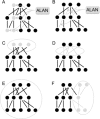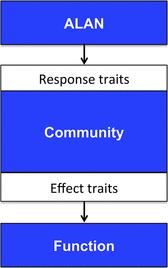How ecological communities respond to artificial light at night
- PMID: 29656458
- PMCID: PMC6220969
- DOI: 10.1002/jez.2157
How ecological communities respond to artificial light at night
Abstract
Many ecosystems worldwide are exposed to artificial light at night (ALAN), from streetlights and other sources, and a wide range of organisms has been shown to respond to this anthropogenic pressure. This raises concerns about the consequences for major ecosystem functions and their stability. However, there is limited understanding of how whole ecological communities respond to ALAN, and this cannot be gained simply by making predictions from observed single species physiological, behavioral, or ecological responses. Research needs to include an important building block of ecological communities, namely the interactions between species that drive ecological and evolutionary processes in ecosystems. Here, we summarize current knowledge about community responses to ALAN and illustrate different pathways and their impact on ecosystem functioning and stability. We discuss that documentation of the impact of ALAN on species interaction networks and trait distributions provides useful tools to link changes in community structure to ecosystem functions. Finally, we suggest several approaches to advance research that will link the diverse impact of ALAN to changes in ecosystems.
Keywords: ecosystem functioning; interaction networks; light pollution; species interactions; stability; traits.
© 2018 The Authors. Journal of Experimental Zoology Part A: Ecological and Integrative Physiology published by Wiley Periodicals, Inc.
Figures



Similar articles
-
Towards a mechanistic understanding of the effects of artificial light at night on insect populations and communities.Curr Opin Insect Sci. 2022 Oct;53:100950. doi: 10.1016/j.cois.2022.100950. Epub 2022 Jul 19. Curr Opin Insect Sci. 2022. PMID: 35868610 Review.
-
Skyglow and especially direct streetlight pollution alter moth communities.Environ Pollut. 2025 May 1;372:126068. doi: 10.1016/j.envpol.2025.126068. Epub 2025 Mar 13. Environ Pollut. 2025. PMID: 40089141
-
How artificial light at night may rewire ecological networks: concepts and models.Philos Trans R Soc Lond B Biol Sci. 2023 Dec 18;378(1892):20220368. doi: 10.1098/rstb.2022.0368. Epub 2023 Oct 30. Philos Trans R Soc Lond B Biol Sci. 2023. PMID: 37899020 Free PMC article. Review.
-
Endogenous cycles, activity patterns and energy expenditure of an intertidal fish is modified by artificial light pollution at night (ALAN).Environ Pollut. 2019 Jan;244:361-366. doi: 10.1016/j.envpol.2018.10.063. Epub 2018 Oct 16. Environ Pollut. 2019. PMID: 30352350
-
Artificial lighting at night alters aquatic-riparian invertebrate food webs.Ecol Appl. 2019 Jan;29(1):e01821. doi: 10.1002/eap.1821. Epub 2018 Dec 19. Ecol Appl. 2019. PMID: 30566269
Cited by
-
Long-term exposure to experimental light affects the ground-dwelling invertebrate community, independent of light spectra.Philos Trans R Soc Lond B Biol Sci. 2023 Dec 18;378(1892):20220364. doi: 10.1098/rstb.2022.0364. Epub 2023 Oct 30. Philos Trans R Soc Lond B Biol Sci. 2023. PMID: 37899017 Free PMC article.
-
The preference and costs of sleeping under light at night in forest and urban great tits.Proc Biol Sci. 2019 Jun 26;286(1905):20190872. doi: 10.1098/rspb.2019.0872. Epub 2019 Jun 19. Proc Biol Sci. 2019. PMID: 31213184 Free PMC article.
-
The impact of artificial light at night on nocturnal insects: A review and synthesis.Ecol Evol. 2018 Oct 23;8(22):11337-11358. doi: 10.1002/ece3.4557. eCollection 2018 Nov. Ecol Evol. 2018. PMID: 30519447 Free PMC article. Review.
-
Human-Centric Lighting: Rare-Earth-Free Photoluminescent Materials for Correlated Color Temperature Tunable White LEDs.Int J Mol Sci. 2023 Feb 10;24(4):3602. doi: 10.3390/ijms24043602. Int J Mol Sci. 2023. PMID: 36835013 Free PMC article.
-
Coping with light pollution in urban environments: Patterns and challenges.iScience. 2024 Feb 16;27(3):109244. doi: 10.1016/j.isci.2024.109244. eCollection 2024 Mar 15. iScience. 2024. PMID: 38433890 Free PMC article. Review.
References
-
- Alexander, J. M. , Diez, J. M. , & Levine, J. M. (2015). Novel competitors shape species’ responses to climate change. Nature, 525, 515–518. - PubMed
-
- Becker, A. , Whitfield, A. K. , Cowley, P. D. , Järnegren, J. , & Næsje, T. F. (2013). Potential effects of artificial light associated with anthropogenic infrastructure on the abundance and foraging behaviour of estuary‐associated fishes. Journal of Applied Ecology, 50, 43–50.
-
- Bennie, J. , Davies, T. W. , Cruse, D. , & Gaston, K. J. (2016). Ecological effects of artificial light at night on wild plants. Journal of Ecology, 104, 611–620.
Publication types
MeSH terms
LinkOut - more resources
Full Text Sources
Other Literature Sources

